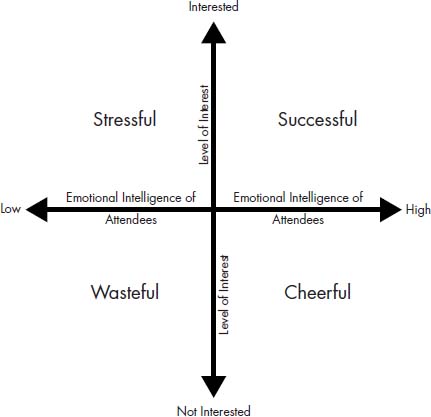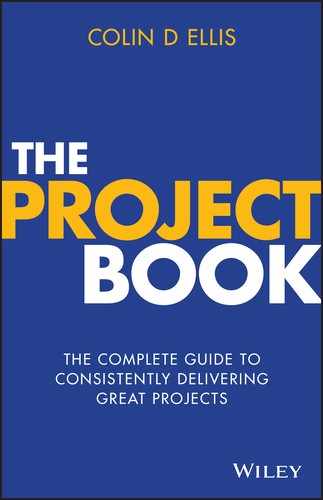CHAPTER 40
RUN MEETINGS THAT DON’T SUCK
We have a problem with meetings. Most of them suck. Like, really badly, and for some reason we seem reticent to do anything about that.
Some fear challenging the existing culture, others have decided to become part of the current culture, and a last group just don’t know how to do it well because the meetings they attend, well, suck.
In the US alone over 25 million meetings are conducted every day and the unproductive ones cost, on average, US$37 billion annually. If ever there was a statistic to persuade us of the need to change the way we do them, that’s it. It’s like buying a membership to a gym, turning up every day, then never exercising. I’ve definitely never done that, and I know you haven’t either.
Meetings are generally unproductive for three reasons:
- The emotional intelligence of the attendees is low.
- The attendees are not engaged in the subject matter.
- The meeting has no structure.
Meetings will fall into one of the following quadrants (overleaf).

- Wasteful meetings are those that just shouldn’t happen at all. These are the ones we call ‘meetings for meeting’s sake’. Either that or they’re talkfests that take 10 minutes of content and spin it out into an hour. They’re a waste of time, energy and, for some, emotion.
- Cheerful meetings are those where we spend the first half hour talking about anything other than what we actually should be talking about. Then when we do get around to the subject matter, we smile and pay it no more than lip-service. No actions, no decisions, no problems.
- Stressful meetings occur when people arrive late and spend the entire time on their phone/laptop/tablet. Or else someone talks for much longer than they should, there are frequent arguments, and you leave the meeting no closer to discussing or resolving the issues at hand.
- Successful meetings are those in which you feel you understand the purpose, your role, the content and the expected outcome. They run exactly to the agenda and finish on or before time. To hold successful meetings, every time, you need to put thought into the approach required to resolve an issue, get a decision or provide an update to a team. Meetings reflect your leadership, the culture you have created and your ability to deliver a project in a timely manner. They need to be good.
Ensure that your meetings have the following features:
- There’s a reason for the meeting (not every conversation has to be a meeting).
- There’s an agenda that’s adhered to.
- If there’s pre-reading, it’s succinct and has been sent out with enough time to give attendees the chance to read it.
- The meeting starts on time and ends early or on time (having achieved its objectives).
- You only invite people — usually no more than six to eight — who will participate (no ‘FYIs’).
- The meeting is well managed and the chair addresses behavioural issues when they occur.
- Guests attend for their slot on the agenda only, not for the whole meeting.
- Devices are put away or on silent, unless being used to take notes (see chapter 8 on active listening).
- Actions are decided on and recapped at the end of the meeting so the owners understand what they have to do.
- There is an element of fun — and preferably chocolate biscuits. Everyone attends meetings in the hope of chocolate biscuits.
- Ensure you use a range of meeting styles and environments, depending on the situation.
The agile software development approach (see chapter 43) has brought the stand-up meeting into the mainstream, which is great. The Japanese have been doing this in manufacturing for years.
I used the Chourei (literal translation ‘morning-bow’) to run every morning meeting with one team I managed. It was a 20-minute opportunity for me to disseminate information from the meetings I had attended the day before, to talk about the work we needed to get done that day, and to check in with the team to ensure they were okay and there were no issues that required resolution.
At another organisation I used a similar approach, but we would go for a walk. Exercise and information — the perfect combination!
Agile stand-ups (as they’re known) introduced visual accountability — in the form of cards — that are updated every morning, so the whole team is aware of progress. At the meetings, held around a large wall that carries a list of the tasks that are time-boxed to 15 minutes or less, individuals provide an update on what they’re currently working on. The meetings are held daily to ensure momentum isn’t lost. This wouldn’t work for all meetings, but it should be considered for those that require a short, sharp appraisal of progress or to ensure the stakeholders know where you’re at.
Regardless of where the meeting is held, how long it lasts or whether you’re sitting down or standing, you need to ensure that all meetings have the characteristics outlined in the previous pages and that they are productive. If your meetings are not achieving their objectives, learn and change the approach for the next one.
Oh, and stop starting them on the hour or at half-past the hour. Microsoft Outlook is to blame for that. Start them at ten past the hour instead, and the attendees may have a chance of getting there on time.
